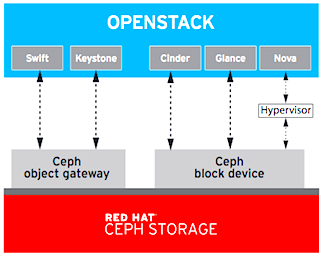München, Starnberg, 8. Juni 2016 - Die Lösung basiert auf OpenStack mit Red Hat Ceph Storage sowie einer Spine-Leaf Fabric, kontrolliert über Neutron-Plugins…
Zum Hintergrund: Zusammen mit Big Switch Networks, Dell und Red Hat hat Verizon nach eigenen Angaben das bislang größte NFV (Network Function Virtualization) OpenStack-Projekt implementiert. Von der Konzeption bis zur Implementierung in den fünf US-Rechenzentren des Unternehmens vergingen demnach weniger als neun Monate. Geplant ist, die Lösung nun in den nächsten Monaten auch in anderen internationalen Verizon-Standorten auszurollen. Die Lösung basiert auf OpenStack mit Red Hat Ceph Storage und einer Spine-Leaf Fabric, bei der jeder Pod (Knoten) mit Hilfe eines Neutron-Plugins durch die Red Hat OpenStack Platform überwacht wird (1).
Die Lösung, bei der Produkte mehrerer Hersteller zum Einsatz kommen, nutzt Big Switch als SDN (Software-defined Networking)-Controller-Software für die Dell-Switches, die ebenfalls von der Red Hat OpenStack Platform verwaltet werden. Um die Zuverlässigkeit eines umfangreichen NFV-Pod-Designs zu validieren, haben Big Switch Networks, Dell, Red Hat und Verizon ausgiebige Tests in produktionsähnlichen Umgebungen durchgeführt und darüber hinaus das Know-how der Open-Source-Community für den Aufbau einer qualitativ hochwertigen und validierten NFV-Pod-Architektur genutzt.
Nachfolgend ein gekürzter Auszug der Orginal-Meldung in englischer Sprache (AUSTIN, Texas – Verizon has completed the industry’s largest known Network Function Virtualization OpenStack cloud deployment across five of its U.S. data centers): "The NFV project, which began in 2015, created a production design based on a core and pod architecture that provides the hyperscale capabilities and flexibility necessary to meet the company’s complex network requirements. Deployments are currently in progress in additional domestic data center and aggregation sites, with international locations to be deployed over the next several months. The design also will be adopted in edge network sites by the end of the year.
Verizon worked with Big Switch Networks, Dell and Red Hat to develop the OpenStack pod-based design that went from concept to deployment of more than 50 racks in five production data centers in less than nine months. To validate the resiliency of the NFV pod design at scale, the collaborators constructed and tested large scale test beds mirroring the production design, leveraging the open source community to ultimately deliver a high quality, validated NFV pod architecture. Executives from Verizon, Big Switch, Dell and Red Hat spoke also about the project at the OpenStack Summit.
(1) The project is based on OpenStack with Red Hat Ceph Storage and a spine-leaf fabric for each pod controlled through a Neutron plugin to Red Hat OpenStack Platform. The multi-vendor deployment leverages Big Switch’s Big Cloud Fabric for SDN controller software managing Dell switches, which are orchestrated by Red Hat OpenStack Platform.
To meet the challenges of a large scale NFV deployment, the companies worked together to design a solution that addressed five key needs identified early in the project:
Resiliency at Scale. The design followed a hyperscale-inspired "core and pod” approach with a 12-rack pod design replicated at data centers across the United States.
No Bandwidth Bottlenecks. A modern leaf-spine Clos design, using centralized SDN control designed to take the network from spine to leaf to vSwitch and avoid bandwidth bottlenecks.
Logical Network Design Flexibility. The pod design accommodates unique NFV workloads with unique logical network requirements that share the same physical leaf/spine fabric and vSwitches.
Reduced Operational Complexity. Operational complexity is reduced through a simplified lifecycle management of the network control systems relative to the OpenStack control systems.
Integrated Security and Visibility. The NFV Pod is designed to be compliant and secure against intrusions and other threats, monitoring fabric was used to monitor intra-pod traffic and inline traffic."
Supporting Quote Adam Koeppe, vice president, network technology planning at Verizon: "Building on our history of innovation, this NFV project is another step in building Verizon’s next-generation network -- with implications for the industry. New and emerging applications are highlighting the need for collaborative research and development in technologies like NFV. We consider this achievement to be foundational for building the Verizon cloud that serves our customers’ needs anywhere, anytime, any app.”
Darrell Jordan-Smith, vice president, Worldwide Information and Communications Technology, Red Hat: With its open NFV architecture, Verizon is building a next-generation, automated, software-defined network based on open source solutions, including OpenStack, giving them the ability to build a network that changes at the pace of software, not at the pace of hardware. We are thrilled to collaborate with Verizon on its SDN-NFV architecture plan, which includes both Red Hat OpenStack Platform and Red Hat Ceph Storage at the core of its open and highly scalable next-generation infrastructure.”
+++ Hinweis: mehr Informationen zum Thema open Software Defined Storage und Red Hat erhalten Sie auch im Rahmen unseres 17. Anwendertreffens am 16. Juni 2016 in Frankfurt/M. auf dem Gelände des e-shelter data-center campus. Eine exklusive RZ-Führung rundet das Angebot ab +++

Abb. 1: Bildquelle Red Hat, Ceph Storage Archtecture
